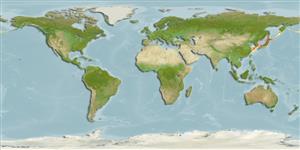Common names from other countries
Classification / Names / Names
Populärnamn | synonymer | Catalog of Fishes (gen., sp.) | ITIS | CoL | WoRMS
Environment: milieu / climate zone / depth range / distribution range
Ekologi
; djupintervall 0 - 80 m (Ref. 289). Subtropical
Northwest Pacific: Korea, Japan, and China.
Length at first maturity / Size / Vikt / Age
Maturity: Lm ? range ? - ? cm Max length : 2.5 cm TL hane/ej könsbestämd; (Ref. 283)
Body elongate, oval shaped; moderately elevated. Valve slate-blue, dark olive-grey or dark grayish brown with blotches of creamy white. Central areas minutely pitted in a chevron-like or quincuncial pattern. Lateral areas slightly raised, clearly marked; sculptured with flat, radiating costae. Girdle narrow; colored like the valves, sometimes with alternating bands of lighter and darker tones; covered with imbricating scales.
Occurs in stony bottoms and in oyster beds (Ref. 289); undersurfaces of stones and rocks (Ref. 1867). Found from intertidal to 80 m (Ref. 75835).
Life cycle and mating behavior
Könsmognad | Reproduktion | Lek | Ägg | Fecundity | Larver
Members of the class Polyplacophora are mostly gonochoric. Life cycle: Eggs hatch into lecitotrophic planktonic trocophore larvae (no veliger stage) which later metamorphose and settle on the bottom as young adults.
Burghardt, G. and L. Burghardt. 2006. (Ref. 283)
IUCN Red List Status (Ref. 130435)
CITES status (Ref. 108899)
Not Evaluated
Not Evaluated
Threat to humans
Harmless
Human uses
| FishSource |
Verktyg
Ytterligare information
Age/SizeTillväxtLength-weightLength-lengthMorfologiLarverAbundans
Internet-källor
Estimates based on models
Preferred temperature
(Ref.
115969): 10.2 - 23.9, mean 17.1 (based on 60 cells).
Vulnerability
Low vulnerability (10 of 100).
Price category
Unknown.
